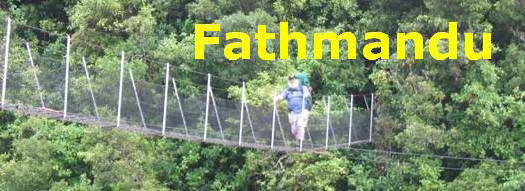
Many thanks for permission to use graphics from their software and toposheets |
 |
|
Sure, we're half way round, according to the sign, but the track continues mostly uphill for another twenty minutes
Here's a fallen tree which has been chainsawed clear of the track and is already host to another generation of plants
Yet another picture of the waterfall, this time from the upper lookout
Just to the left of the lookout is a whau (Entelea arborescens) in seed. Whau wood is the lightest in the world, lighter even than balsa. It is unique in being the only endemic New Zealand tree to have seeds encased in spines. ["Arborescens" means "like a tree", and "Entelea" I have been unable to source an origin for.] Growing up the side of this tree is Metrosideros perforata, the small-leaved rata. [Metrosideros is derived from Greek metra (heartwood) and sideros (iron) relating to the hardness of the wood, and perforata. full of holes, presumably relates to the dotted appearance of the leaves.]
I suspect this is black maire, Eugenia maire.
It's time for a rest and a look out across the Manukau Harbour.
One or two lovely big kauri still around. You can smell the gum oozing from this one from several metres.
A dead punga rests in a nest of parataniwha.
The track is now much more steeply downhill and we have lengthened our poles accordingly. In places, the track is clay and quite slippery. I am glad of the extra stability from the poles.
One more old friend from our Lane Cove walk with Tony: mangemange.
Back to the carpark. It has been a warm and exceptionally humid day and as we are carrying close to full 16-18kg backpacks, we are both soaked in perspiration. But we plan to return for a few more walks around the area as part of our training buildup for the St James Walkway in early March 2006.
|
|